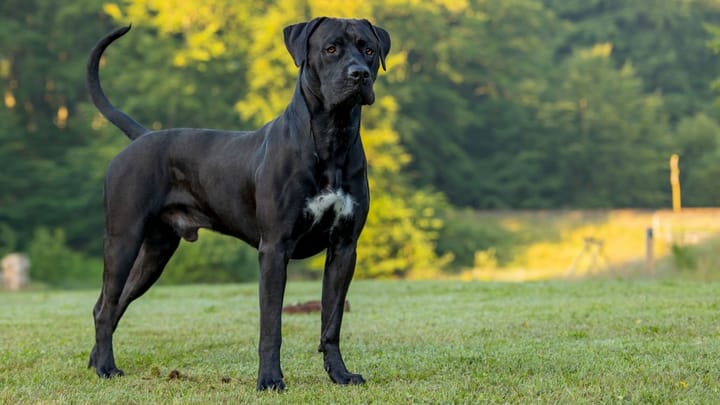Presa Canario (Canary Mastiff)
Other names : Perro de Presa Canario, Canarian Dog


The Canarian Dog is a dog with a natural suitability for guarding and defending which, in the past, can be compared to Bouviers. This breed was predominantly used as a fighting dog until this practice was banned. Canarian Dogs have a reckless temperament, they tend to be fearless and almost insensitive to pain. However, they are balanced and caring as a family but sometimes fight amongst themselves.
|
Life expectancy |
The Presa Canario (Canary Mastiff) has a life expectancy of between 8 and 12 years |
|
Temperament |
|
|
Size |
Large
|
|
Adult size |
Female
Between 22 and 24 in
Male
Between 24 and 26 in
|
|
Adult weight |
Female
Between 88 and 121 lb
Male
Between 110 and 143 lb
|
|
Coat colour
Their coat can be brindle (from dark to light grey or blond) or fawn (from darker to a gritty colour). White marks are common but not sought after. Their face is always black. |
Blue Red |
|
Type of coat
They have a short coat. Their coat lies close to their body and is rough to the touch and they have no undercoat. |
Short Hard |
|
Eye colour
The eye colour varies from dark to medium brown, without being too light, depending on the coat. |
Brown
|
|
Purchase price |
The Presa Canario (Canary Mastiff) costs approximately 730£ |
Given their size, the Canarian Dog, if not experienced enough, have no choice and must be accompanied by their master who is confident in their ability to keep them under control. It should not be forgotten that a poorly trained dog who has not been subjected to enough social interaction is potentially very dangerous.
More details about the Presa Canario (Canary Mastiff)
Presa Canario (Canary Mastiff): Origins and history
This species comes from the islands of Tenerife and Gran Canaria, in the Canary Islands, where they are brought up as a fighting dog. This comes from the Bardino, a dog that is very aggressive with a fighter's instinct from the island of Fuerteventura, although they are not very big. The size of the Canarian Dog has grown through breeding the species with Mastiffs and other large hounds found on the islands. In 1946, when dog fighting was illegal, they came close to total extinction. Although later on, a group of enthusiasts, supported by the Assessor of Agriculture and Fisheries in the Canaries, made it possible to recover the breed which was only recognised by the FCI definitively, in 2011.
Physical characteristics of the Presa Canario (Canary Mastiff)
The Canarian Dog is of average size, robust and muscular, with a large head and a wide skull. They are also rustic in appearance and well proportioned. The skull to muzzle ratio is about 6/4; their upper lips fall back, a little flabby, on the lower lips. Their eyes are average sized and are slightly oval. Their ears, set high, are set apart and in the shape of a rose. The neck is broad and muscular and has a slight dewlap. The tail is set high: large at the base and it gradually tapers towards its tip. The belly is set back, but the last ribs are not prominent, giving an harmonious harp shape. Their legs are strong, muscular and perfectly straight; the buttocks are not very pronounced.
Presa Canario (Canary Mastiff): Characteristics
Presa Canario (Canary Mastiff): Behaviour
Training a Presa Canario (Canary Mastiff)
This breed is easy to train as they are very attentive and tend to have a well-balanced mind. They are committed to pleasing their owner, although only if they are respectful in their training methods.
The key to obtaining results with this breed is to be gentle and patient with them. It is widely advised to start teaching and integrating them as soon as they come home as a puppy.
Social integration is key, these dogs must weigh around 132 lbs to enable themselves to cope with any type of environment.
Presa Canario (Canary Mastiff): Lifestyle
Breed compatibility Presa Canario (Canary Mastiff)
Presa Canario (Canary Mastiff): Purchase price
The price of a Canarian Dog varies according to its origin, age and gender but it can be said that on average they cost £730 if they registered with the KC.
An average budget to support a dog of this size would be about £60/month.
Presa Canario (Canary Mastiff): Shedding
Light
Without undercoat, these dogs moult very little. The rest of the time, they lose almost no hair (especially if brushed regularly).
Presa Canario (Canary Mastiff): Grooming
These dogs do not need grooming. Only weekly brushing is required to maintain a well groomed coat.
Their droopy ears require regular care to avoid infection.
Presa Canario (Canary Mastiff): Health
Their estimated life expectancy is 10 years.
As a very robust dog, their growth must be carefully monitored.
These dogs are used to high temperatures because of their origin and they are therefore not particularly sensitive to heat.
Without an undercoat, the Canarian Dog can suffer from the cold but they will still remain resilient.
If they are walked enough each day, the Canarian Dog has no reason to get fat, especially since they are not particularly greedy and can quickly burn off the calories they consume.
- Hip and elbow dysplasia
- Panosteitis
- Osteochondritis dissecans (knee injury)
Do you want a Presa Canario (Canary Mastiff) dog ?
Oh no...
There are no Presa Canario (Canary Mastiff) adoption profiles at the moment...




